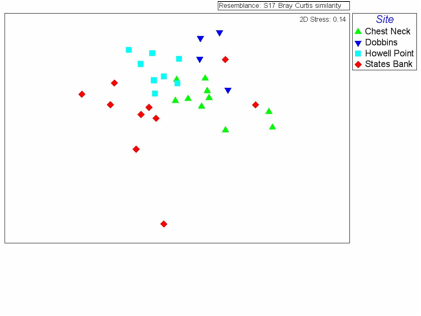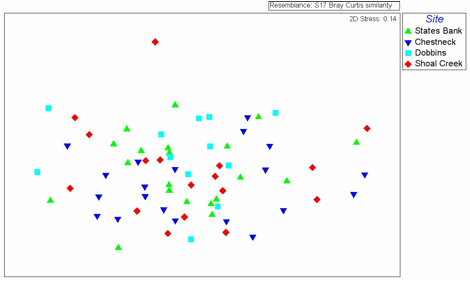 |
 | |
Lipid chemistry of oyster eggs in relation to oyster age and location
Oysters were collected from the Choptank and Magothy rivers in both 2010 and 2011 for this experiment. In 2010, oysters were collected about 14 days prior to spawning and were brought directly into the hatchery after collection in order to acclimate to the hatchery environment. In 2010, oysters from the Choptank River were 3 and 9 years old and oysters from the Magothy River were 4 and 11 years old. In 2011, once oysters were collected, they were kept in plastic floats in a boat basin that has limited water exchange with the Choptank River for the winter and then moved into the hatchery 14 days prior to spawning in order to acclimate to the hatchery environment. For the 2011 spawn, oysters were collected from the same sites as 2010; therefore oysters from the Choptank River were 4 and 10 years old, respectively and oysters from the Magothy River were 5 and 12 years old, respectively. The figure below is a map of the sample collection locations for the 2010 and 2011 spawning events. Once the animals were collected, they were spawned at the Horn Point Oyster Hatchery with the help of the hatchery staff. Eggs from all spawned females were counted and the amount and composition of the lipids from the eggs was determined in collaboration with the University of North Carolina Wilmington. The shell height, mass and dry weight of all spawned oysters was also determined. In general, no significant trends were found in number of eggs spawned or the total amount of lipid in eggs of females from different sites or of different ages. However, trends were found in the composition of the lipids of the eggs from spawned females from different sites. The lipid composition is a way of quantifying what types of lipids are in a specific organism (or egg, in this case). Certain lipids have specific physiological roles, such as the omega-3 and omega-6 fatty acids that are important for growth and development of all living things. The composition of lipids in an organism is mostly determined by diet, although some lipids are made by certain animal themselves. Quantifying differences in the lipid composition of oyster eggs can tell us about whether or not all oyster eggs are biochemically the same or if differences in the environment can cause differences in the composition of eggs. We found that when oysters were collected from different locations and spawned directly after (2010 data), significant differences existed in the lipid composition of their eggs (Figure 1).
Figure 1. Lipid composition of eggs from females spawned in 2010. Each symbol represents one individual oyster and different sites are different shapes and colors. Generally, individuals grouped with other individuals from the same site.
Figure 2. Lipid composition of eggs from females spawned in 2011. Each symbol represents one individual oyster and different sites are different shapes and colors. Unlike 2010 data, no grouping among sites was observed. We believe this is evidence that the lipid composition of oyster eggs is related to the environment that the female is in when she is making her eggs. The next step in this study will be to conduct the experiment in a controlled setting in the lab as well as determine if the differences in the lipid composition has any impact on the fertilization success and survival of oysters. For more information and detailed data on the egg lipid project, please email us at paynteroysterlab@gmail.com.
|
||

